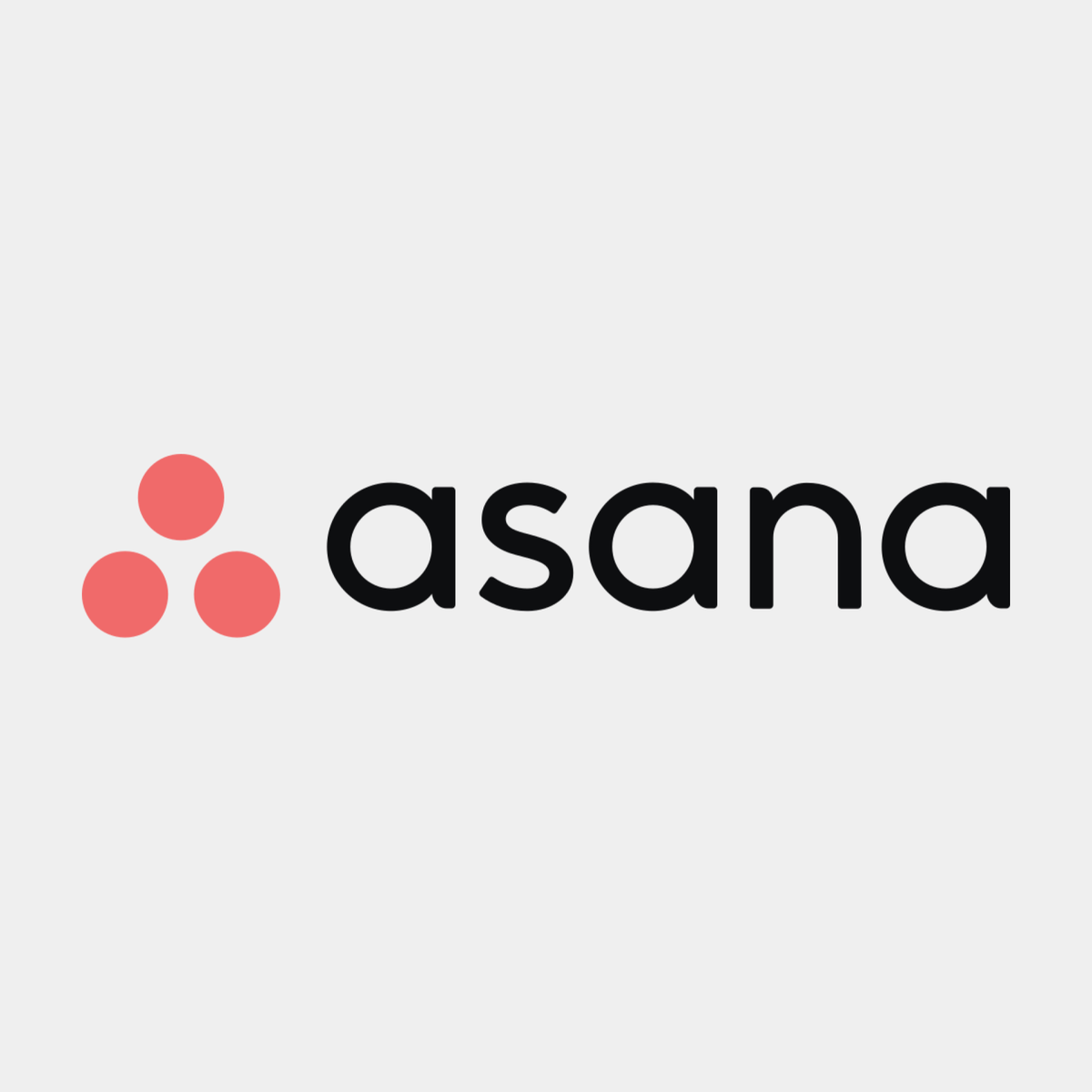Asana review |
|
|---|---|
| Rating | 3.9/5 |
| Starting price | $10.99 per user per month, billed annually or $13.49 billed monthly |
| Key features |
|
Asana has long been considered one of the best project management software. While it has a steep learning curve compared to other competitors, it does deserve its high-ranking status. With Asana, you get a cloud-based platform that offers a robust free plan for small teams. It also offers premium features that have the potential to transform business process management for deployment in large organizations. Our Asana review will examine the platform’s key features, use cases, pricing plans and top alternatives.
Jump to:
- What is Asana?
- Hands-on Asana review results
- Asana pricing
- Core Asana features
- Asana ease of use
- Asana customer service and support
- Asana pros and cons
- Best uses for Asana
- Asana integrations
- Who is best Asana for?
- Asana alternatives
- Asana review methodology
What is Asana?
Asana is work management software that offers project and task management tools, team collaboration features and productivity capabilities. The company’s cloud-based platform includes a stack of tools to help team members re-visualize and optimize project workflows.
The Asana platform includes features for general and niche project management teams to collaborate in real-time on project tasks. While organizations increasingly adopt hybrid infrastructure environments, Asana helps promote seamless communication between remote team members, integrate critical data from third-party applications and automate business processes.
Hands-on Asana review results
We gathered information about Asana from our hands-on testing, the Asana website and other reputable review sites. We scored the tool based on categories and sub-categories. Each category is scaled to five points, and the overall score is scaled to 100 points to generate our composite score.
| Criteria | Score |
|---|---|
| Features | 4.9/5 |
| Pricing | 2/5 |
| Ease of use | 5/5 |
| Service and support | 2.9/5 |
Asana pricing: 2/5
| Pricing Plan | Cost/month (per user, billed monthly) | Cost/month (per user, billed annually) |
|---|---|---|
| Basic | Free forever | Free forever |
| Premium | $13.49 | $10.99 |
| Business | $30.49 | $24.99 |
| Enterprise | Custom quote | Custom quote |
Asana is available as a free trial, free plan or paid SaaS subscription, giving small and large teams the tools and centralized console to efficiently work through project tasks.
Basic
The Basic plan, which is Asana’s free tier, serves up to 15 collaborators and includes features such as list and board view projects, unlimited task creation, messages, activity logs, project and team management and integration with other tools. This plan serves as an ideal option for freelancers and individuals seeking to better structure their projects at no cost. However, as the complexity of projects increases and teams become bigger and more interdependent, the Basic plan will no longer be sufficient.
Premium
The most affordable paid plan is Asana Premium, which costs $13.49 per user per month when billed monthly or $10.99 per user per month when billed annually. Premium offers users additional project management features like advanced reporting; the ability to set milestones, task dependencies and customizable dashboards; and a workflow builder. Small and mid-sized teams are more likely to appreciate the Premium tier. It delivers a bird’s eye view of complex projects to project managers and offers managers access to key features for team coordination.
Business
Priced at $30.49 per user per month when billed monthly or $24.99 per user per month when billed annually, the Business plan provides additional features for growing teams. It offers Portfolios, a feature that gives an overview of the progress of all active projects a team has. It also has the Workload feature, which shows the workload assigned to every team member. Other differentiating features of the Business tier include forms, proofing and the ability to lock custom fields.
This tier is mostly beneficial to larger companies and organizations that need to correctly track all their projects, maintain greater inter-project and interdepartmental control and significantly enhance the customization of their project management processes.
Enterprise
Asana offers an Enterprise plan that is customized to the needs of large enterprises. It delivers SAML, data export and deletion, user provisioning, custom branding and more. It is worth noting that this is the only plan that offers 24/7 support. However, its pricing information is not publicly available, meaning prospective users will have to contact Asana’s sales team for more information.
Core Asana features: 4.9/5
Importing existing project data
Users have the option to import project data through a CSV file, email or Wufoo. CSV is the most popular import method, but Asana offers additional guidance on how to import data from other apps like Airtable, Google Sheets, monday.com, Trello, Smartsheet and Wrike.
For our ongoing PM software review series, I was able to download our Google Sheets template as a CSV and upload it to the Asana space. From there, I saw a clean preview of the project data and double-checked it before I confirmed the import.
Upon first look, the imported data looks very similar to our original spreadsheet, with minimal exceptions (Figure A). Asana recognized deadlines, team member names, task status, completion percentage and duration. However, it did not include the start date column or percentage complete, and it failed to recognize the relationship between parent and subtasks. As seen below, all tasks imported were put under the initially submitted category, Not Started.
Figure A: Users can import data from an existing project tool to avoid duplicating data input.
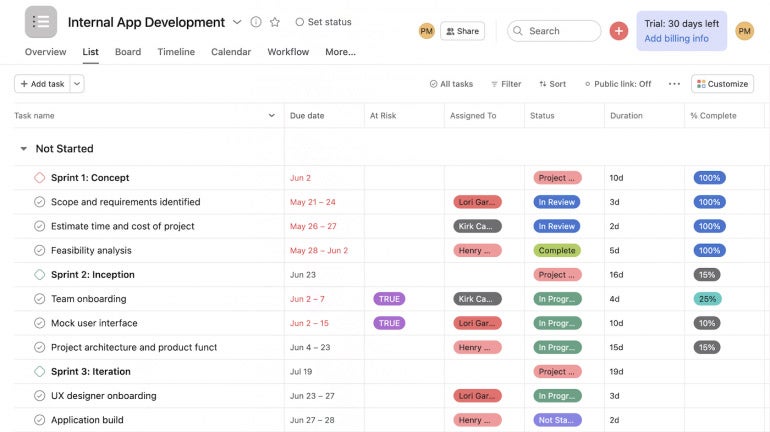
To ensure project data on Asana reflects our legacy Google Sheets file, and before the rest of the team joined, I moved columns into similar locations and hid irrelevant columns.
The process for indenting tasks into their sprints as subtasks was a tad more involved. Users must first double-click the intended parent task, which, in this case, is each sprint. This will open an in-app window on the right-hand side (Figure B), showing task details and tools to attach files, create a subtask, copy and share the task link, add a comment and more.
Figure B: The List view looks similar to a spreadsheet and allows users to view, modify or communicate through task details.

To create a subtask from existing tasks, I opened the intended parent sprint and dragged each subtask from the left into the parent task’s details section. Most PM tools struggle with the parent task and subtask relationship; even so, I found this process less intuitive and more tedious than most.
Managing project data
A shortcut to managing project data across the platform, including columns, is the Customize button, which is found at the top right of every project view. When selected, an in-view window (Figure C) opens on the right-hand side with controls for field data (columns), rules, applications, forms and task templates.
Figure C: The Customize button allows users to change project parameters and incorporate other tools for easing workflows.
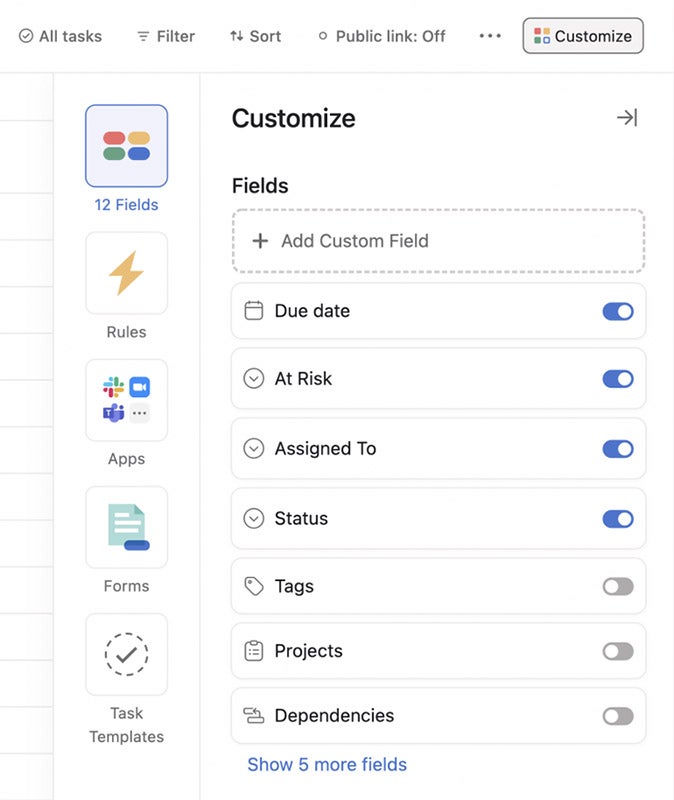
Custom controls for project data
Through the Customize window, users can manage some of the top-level controls for all data related to the project. Here are some examples of those custom controls:
Fields: Set values for project data inputs
In the List view, fields are the values featured in each column with corresponding row tasks. In Figure C, shown above, a handful of columns are selected to show in the List chart, while Tags, Projects, Dependencies and other fields are hidden.
Users can select Add a Custom Field and choose between single-selection, multi-selection, text or numerical values for a new column. However, options that you might find in other project management platforms, like checkboxes and formulas, don’t appear here.
Rules: Automate common workflows
With the Rules component (Figure D), users can choose from a list of common workflows or create a custom workflow to automate tasks.
Figure D: The Rules engine allows teams to automate workflows with built-in templates or a rule generator.
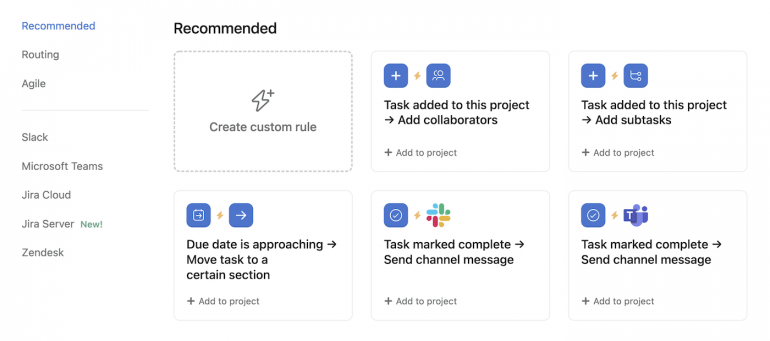
All automations consist of triggers that initiate one or multiple actions. Triggers might be pulled into action when a task is added, updated or overdue, while actions are part of an even longer list of options that include the following:
- Moving or updating a task and creating new subtasks or approvals.
- Sending notifications to Slack or Microsoft Teams users.
- Creating new issues in Jira Cloud or Jira Server.
Asana’s deep partnerships with other applications are evident from the wide array of connections with popular industry applications like Zendesk, Bitskout, Jotform, PageProof and Flowsana.
When creating a new rule, users’ options include 17 triggers and almost 40 actions teams can use to build workflows. For Premium plan holders and above, Asana’s rules engine can ease workloads for team members while maintaining communication between stakeholders and moving tasks along in the project pipeline.
Apps: Connect critical integrations
In addition to the automation-focused applications listed above, users can explore Asana’s extensive list of integrations that address file sharing, reporting, sales, operations and software development needs. You can check out Asana’s complete Application Directory if you don’t spot your favorite app in the in-platform window. Figure E highlights a number of popular connectors.
Figure E: Choose from a wide array of integrations for data import and workflow automations.

Other notable enterprise IT applications include:
- Azure Active Directory.
- Drata.
- Exterro.
- Google Workspace SAML SCIM.
- MuleSoft.
- Okta.
- OneLogin.
- OneTrust.
- Panther.
- ServiceNow.
- Splunk.
- Workato.
- Zylo.
Task templates: Simplify task creation
Teams that regularly execute similar processes — like fulfilling an IT service ticket or tracking application bugs — can convert workflows into task templates for consistent setup. Like any other task details, users can set up the data that repeats from task to task and re-use the template with adjustments when organizing future sprints.
Tasks are easy enough to create, and capabilities like these decrease the overall number of clicks and effort a project lead or team member needs to make to appropriately arrange data. Like so many features available on Asana, these tools can directly reduce the time spent on monotonous tasks and give more time back to stakeholders.
Visualizing and modifying project data
To help project stakeholders gain insight into the status of their projects, Asana offers a handful of visualizations to view and interact with project data. While one team member can stick to the familiar List view that resembles an Excel spreadsheet, other users can change task data through a kanban-style board or calendar. Changes are pushed to each of these views in real-time.
Within an individual project, users can explore the tools listed below or add files and send team-wide messages for ongoing communication and updates.
List view: The advanced spreadsheet
For professionals who are comfortable with the classic spreadsheet, Asana’s List view offers a similar feel without the formulas and functions that sometimes bog down newer spreadsheet users.
Field values are determined by column conditions, while rows represent tasks with the additional option to divide rows into separate sections. Whereas spreadsheets are all rows, it did take me a moment to adjust to this initial division of tasks into sections. Otherwise, users can view and change items easily or add a new column.
Board view: Cards across a whiteboard
The Board view includes a kanban chart, featuring cards and tasks split across lanes based on a set condition. Users can easily drag and drop these cards vertically or horizontally to change a card’s status.
In Figure F, my Board view shows lanes split by section names previously set in the List view. This offers another nice way to see project tasks over each sprint, but kanban charts really shine when it comes to displaying the concentration and movement of tasks based on progress status.
Figure F: Board view resembles a Kanban chart for dragging and dropping cards through lanes.
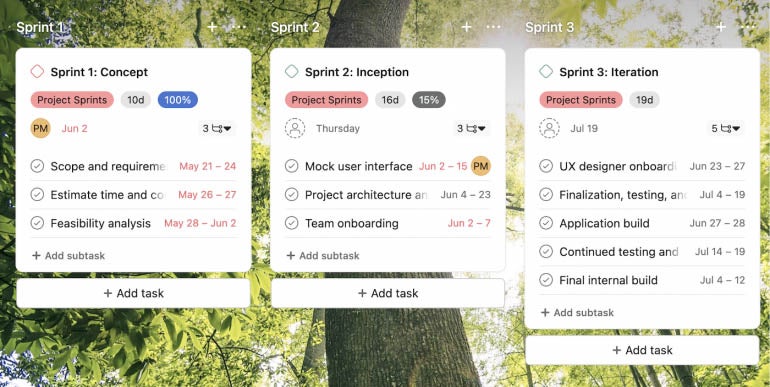
In its current state, my Board allows me to move tasks from one sprint to the next, but I don’t want the expectation of delaying tasks or shifting them to future sprints. To make the ideal arrangement of lanes, I need to adjust sections and tasks. Sadly, I didn’t find an easy or intuitive way to make this shift for the project data.
During the onboarding process, I selected the above background; however, upon seeing my project in Board view, I was not a fan. After several minutes of looking for a way to change the background, I gave up and embraced the forest where my project’s board would reside.
Timeline view: Tasks over time
In a Gantt-style chart, the Timeline view offers the rows of tasks seen in the List view across a timescale. This perspective gives a solid overview of how long each sprint lasts and the dependencies between tasks.
In Figure G, I switched the view to Quarterly to see the entirety of the three-month project and the connections to each.
Figure G: Timeline view displays tasks and their dependencies over a timescale.

The thin blue line between Sprint one and two marks the current date for considering progress toward goals, and users can filter the view through start date, due date and assignee. Like List and Board views, the Timeline also allows users to open and modify task data reflected across the entire project.
Calendar view: Mark the date
Calendar view can be another useful feature for seeing project data on a standard web calendar. However, relative to other calendar components in PM tools, I was underwhelmed by Asana’s version.
Users can scroll through the calendar to see pertinent task dates and add new tasks, but they don’t have the option to import an existing calendar or export the project calendar to a preferred calendar application.
Dashboard view: Break down data with charts
The Dashboard view is another convenient way to visualize project data through familiar charts and graphics. Whereas other views are all-encompassing for project data with the option to filter, dashboards give users the ability to add charts based on project data points and improve observability for team members.
In Figure H, I set charts to display task data by sprint, status, assignee and completion rate.
Figure H: Dashboards offer custom widgets to visualize data points across conditions and values for the project.
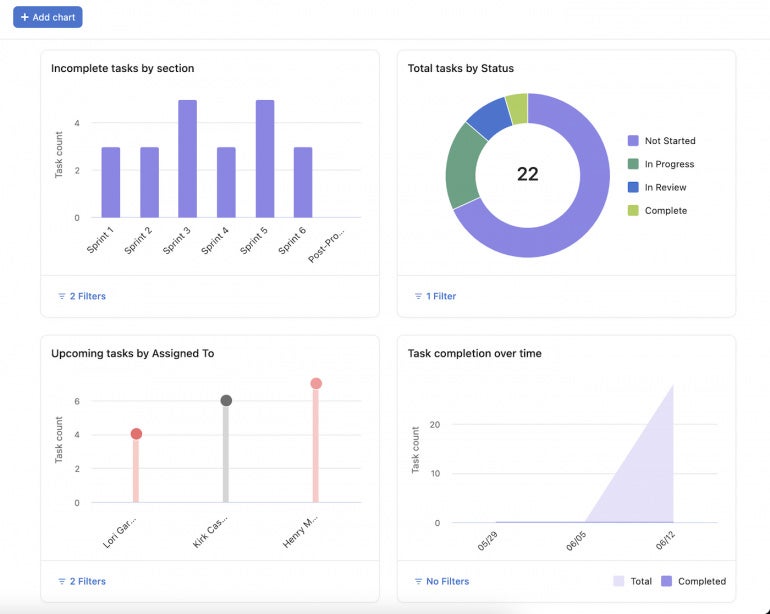
These charts, as well as the option to create others with a range of conditions based on project data, mean teams can quickly break down data into insightful charts for team access. As the project moves forward, my selected charts will help inform decision-making around team member workloads, project progress analysis and future task planning.
Overview view: The homepage of the project
For every project, the Overview page seen in Figure I offers a home for users to see their project status, roles, milestones, goals and key resources like pertinent documentation. Project managers can add a personal message and configure the remaining sections to give team members a full view of project guidelines and progress in day-to-day workflows.
Figure I: The project Overview includes overarching project guidelines, commentary and status for team members.
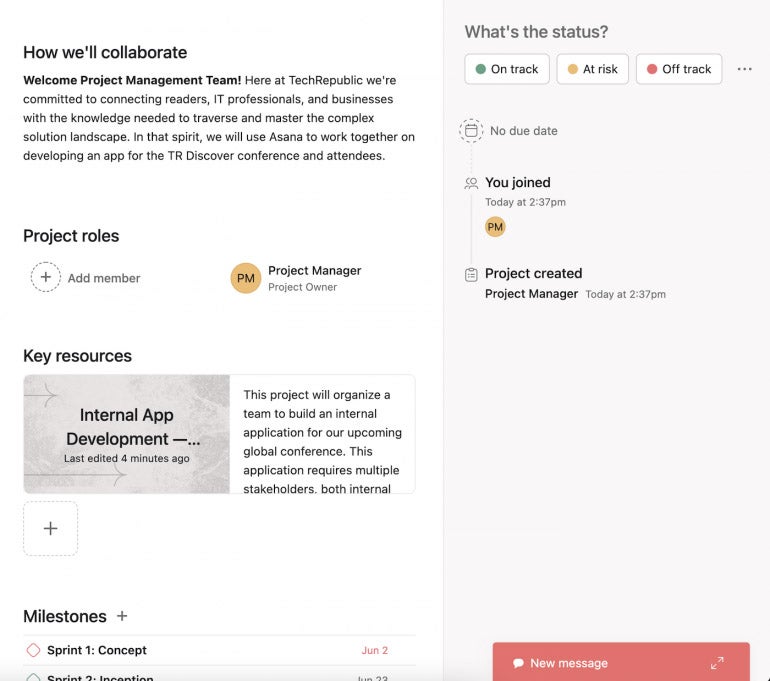
Asana ease of use: 5/5
Asana received a perfect score of 5 out of 5 for being an easy-to-use project management software. Users find Asana to be user-friendly and intuitive. The interface is intuitive, making it easy to navigate and understand. The dashboard provides a clear overview of all your tasks and projects, allowing you to see what needs to be done and when quickly.
In scoring this category, we considered several factors, including the availability of iOS and Android mobile apps, built-in automation, ease of setup, scalability, user interface and onboarding/learning curve.
Asana customer service and support: 2.9/5
Knowledge Base/Help Center
Asana has a comprehensive Knowledge Base/Help Center, where users can find answers to their questions and learn how to use the platform effectively. The Help Center is well-organized and includes a wide range of articles, tutorials and video guides. Users can search for specific topics or browse through different categories, such as getting started, task management, team collaboration and more.
Service channels
Asana offers various service channels for users to get support and assistance. You can reach out to Asana’s support team via email, which allows you to submit a support ticket and receive a response from the team. Asana has an extensive Knowledge Base/Help Center, as mentioned earlier; apart from these channels, it also offers community forums and discussion boards where users can connect with other Asana users, ask questions and exchange tips and insights. Meanwhile, some users have remarked that they would prefer more personalized support, such as phone or live chat options, instead of relying solely on email or support tickets.
Live training
Asana conducts webinars and virtual events to educate users about different features, best practices and new updates. These sessions provide an opportunity to interact with experts and learn from real-life use cases.
Asana pros and cons
| Pros | Cons |
|---|---|
| Variety of import options. | Steep learning curve. |
| Amenable to team-specific workflows. | Unintuitive UI. |
| Various project data visualizations. | Task limitations. |
| Access to third-party solutions. |
Best uses for Asana
Asana has over 139,000 customers across a wide range of industries and team needs. The project management leader highlights its core use cases and target clients, as listed in the sections below.
Project management
Asana provides a central platform for teams to communicate, share files and collaborate on tasks. It helps streamline workflows, facilitate discussions and enhance team productivity.
Agile project management
Asana offers features that can support agile development methodologies, such as Kanban boards, sprint planning and task prioritization. It helps development teams manage their work backlog and track progress efficiently.
Marketing campaigns
Asana provides tools to plan and manage marketing campaigns. Teams can create campaign briefs, assign tasks to team members, track deadlines and monitor campaign performance.
Roles and teams
- Company-wide and managers.
- Designers and design teams.
- Engineers and software development teams.
- Event planners.
- Finance teams.
- Human resources teams.
- IT departments.
- Product management teams.
Asana integrations
- Outlook: With the Outlook integration, you can create and assign tasks, set due dates and add tasks to different projects without leaving your Outlook email inbox.
- Zoom: Enjoy simpler meeting scheduling with Zoom and Asana integration. You can also create and share meeting links, recordings and transcripts.
- Jira: This integration allows for easy collaboration across these two Atlassian platforms. You also get data sync capabilities to minimize duplicate work across the platforms.
- Microsoft Suite: Asana integration with several Microsoft applications, including Power BI to build custom dashboards and OneDrive for quick and easy file sharing.
Who is Asana best for?
Asana is flexible and versatile project management software that offers numerous use cases. It is feature-rich software offering a variety of predefined workflow templates, multiple project views and outstanding data import and export capabilities. Asana is best suited for managing complex projects that require scalability.
Keep in mind that the advanced tools have a steep learning curve, so Asana is not ideal for teams that need basic project management. Organizations that need an on-premises project management solution will have to look elsewhere as Asana does not offer this feature.
With Asana, you get a structured and organized approach to project management to help you manage multiple projects. You also get an extensive range of third-party integrations to help extend Asana’s functionality based on your project management needs.
Asana alternatives and competitors
While Asana is one of the best project management solutions on the market, it is not for everyone. For example, teams that require basic project management might find Asana overly complicated to use. If you feel Asana is not a good fit for your needs, check out these top Asana alternatives:
| Asana | Wrike | ClickUp | monday.com | |
|---|---|---|---|---|
| Workflow automation | Yes | Yes | Yes | Yes |
| Gantt charts | Yes | Yes | Yes | Yes |
| Native time tracking | Limited | Yes | Yes | Yes |
| Budget tracking | No | Yes | No | Yes |
| Free plan | Yes | Yes | Yes | Yes |
| Starting price (billed annually) | $10.99 per user per month | $9.80 per user per month | $7 per user per month | $8.00 per user per month |
Wrike

Wrike and Asana both offer excellent team collaboration features. With Wrike, you get a more visual interface that is also easier to navigate. While Asana has a more extensive range of third-party integrations, Wrike offers a wider range of features, such as budget tracking tools. You can read our full Wrike review to learn more.
ClickUp

ClickUp and Asana offer a comprehensive set of features. If you need project management software with robust Agile support, ClickUp is a better choice compared to Asana. The starting price of ClickUp is also significantly cheaper compared to Asana. You can read our full ClickUp review to learn more and also find out how ClickUp compares to Asana.
monday work management

monday work management and Asana have several similarities and cater to similar target audiences, ranging from small businesses to large enterprises. However, monday work management offers more customization and pre-built templates for a variety of functions, including templates for marketing and creative teams. With monday work management, you also get more powerful automation capabilities. You can read our full Monday review to learn more and see how Asana compares to monday work management.
Asana review methodology
We created this Asana review based on personal experience registering, configuring and executing a project in Asana. We ran a free trial of the Business plan to test this tool and applied the following weights to each assessment category:
- Pricing: 25%
- Core features: 35%
- Ease of use: 15%
- Customer service: 15%
- Expert analysis: 10%
We created a sample project to gain first-hand experience with the workings of Asana. We used the tool via its available channels — web browser, desktop application and mobile application — to learn about its usability on various platforms.
